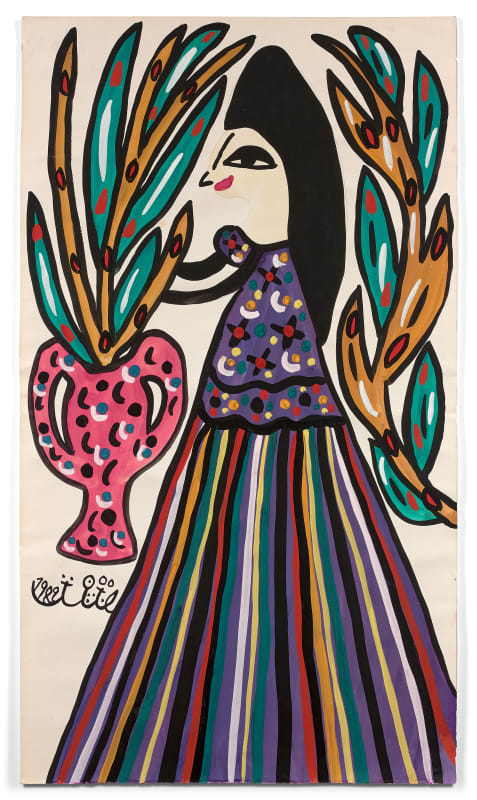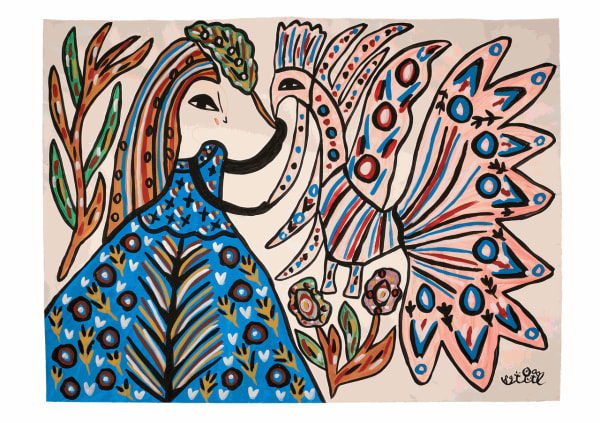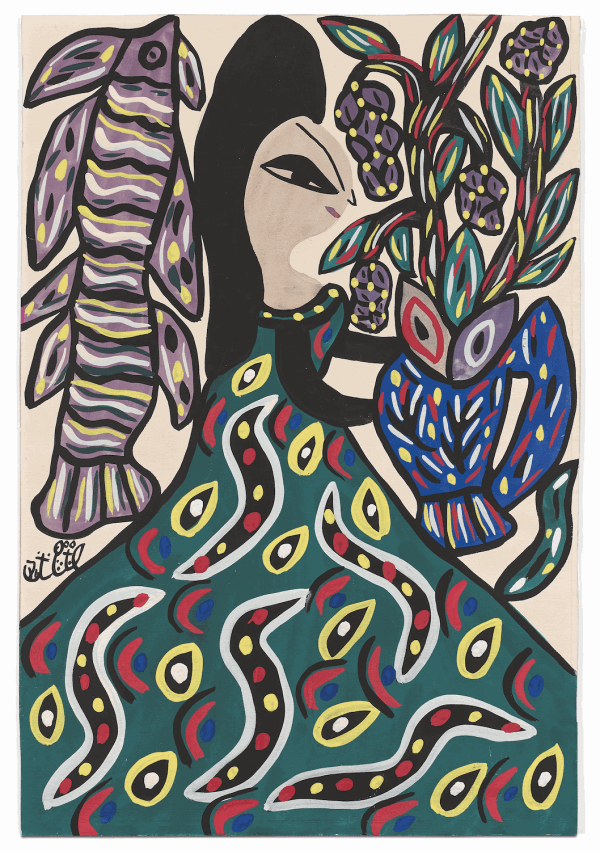Baya Mahieddine Borj El Kifan - Blida, 1931-1998
Born Fatma Haddad in 1931 in Bordj El Kiffan (then Fort-de-l’Eau), Algeria, Baya Mahieddine is recognized as one of the pioneering and most influential figures of modern Algerian art. Alongside contemporaries such as M’Hamed Issiakhem, Abdelkader Guermaz, and Mohammed Khadda, she laid the foundations of postcolonial art in North Africa. Frequently associated with Surrealism and often compared to Frida Kahlo for the symbolic and intimate nature of her work, Baya consistently drew inspiration from her cultural heritage and inner world.
Orphaned at the age of five, she was first raised by her grandmother and later by Marguerite Caminat, a French patron and collector living in Algiers, who nurtured her early artistic talent. Self-taught, Baya began as a child to create vivid gouaches and ceramics inspired by Kabyle traditions, the natural world, and her imagination.
At just sixteen, she was discovered by the art dealer Aimé Maeght and held her first exhibition at Galerie Maeght in Paris in 1947. The exhibition catalogue was prefaced by André Breton, and that same year she took part in the International Surrealist Exhibition. Her work quickly attracted the admiration of Jean Dubuffet and Pablo Picasso, whom she encountered at the Madoura ceramic studio in Vallauris, an artistic exchange often cited as an indirect influence on Picasso’s celebrated Women of Algiers series.
In 1953, Baya returned to Algeria, married the musician El Hadj Mahfoud Mahieddine in Blida, and started a family. During the Algerian War of Independence (1954-1962), she largely suspended her artistic practice. Encouraged by Jean de Maisonseul, then director of the Musée des Beaux-Arts in Algiers, she resumed painting and exhibited in Algiers in 1963 and in Paris in 1964. In 1971 she was awarded the Second Prize of the Union Nationale des Arts Plastiques (UNAP). A major retrospective of her work was presented at the Musée Cantini in Marseille in 1982, inaugurated by President François Mitterrand, Minister of Culture Jack Lang, and the Mayor of Algiers.
Baya chose to remain in Algeria throughout her life, even during the turmoil of the 1990s civil war. She passed away in Blida in 1998. Since then, her work has received broad international recognition, with retrospectives at Grey Art Gallery, NYU (2018), the Sharjah Art Museum (2021), the Institut du Monde Arabe, Paris (2022), and the Vieille Charité, Musée de Marseille (2023).
Her works are now held in major public collections, including the CNAP, the Institut du Monde Arabe, and the Maeght Foundation (France), Mathaf (Doha), Sharjah Art Museum and the Barjeel Art Foundation (Sharjah), as well as the Dalloul Foundation (Beirut). Today, Baya is celebrated as a central figure of modern and contemporary art, an artist whose singular vision continues to inspire across borders and generations.
-

Présences croisées – Crossed Presences
27 Jun - 6 Sep 2025In conjunction with an exceptional conversation marking the launch of the English version catalogue Arab Presences | Modern Art and Decolonisation – Paris 1908–1988 , published by Zamân Books in...Read more -

Baya : Femmes, oiseaux, fleurs et luth
Baya Mahieddine (1931 - 1998) 21 Dec 2022 - 29 Jan 2023Coinciding with the exhibition « Baya, icône de la peinture algérienne Femmes en leur Jardin » at the Institut du Monde Arabe in Paris, the gallery is showing a selection...Read more -

Positions and Points of View | Partis Pris et Points de Vue
Group Show 8 Sep - 9 Oct 2022Positions and Points of View By Natasha Boas Ph.D, International Curator Lilia Ben Salah presents Positions and Points of View, the inaugural exhibition of her new gallery centrally located in...Read more
-

Présences Arabes - Art moderne et décolonisation Paris, 1908 - 1988
Musée d'Art Moderne de Paris April 3, 2024The exhibition 'Arab Presences - Modern Art and Decolonization Paris, 1908 - 1988', which opened on April 3, 2024 at the Musée d'Art Moderne in...Read more -

"Rien ne me manque" Baya & Czermak Ichti au musée des Beaux-Arts de Nîmes
Première édition de la Contemporaine de Nîmes. Du 5 avril au 10 octobre 2024 April 16, 2024C’est un dialogue artistique intergénérationnel exceptionnel qui prend place au Musée des Beaux-Arts de Nîmes. La jeune peintre Neïla Czermak Ichti expose aux côtés de...Read more











